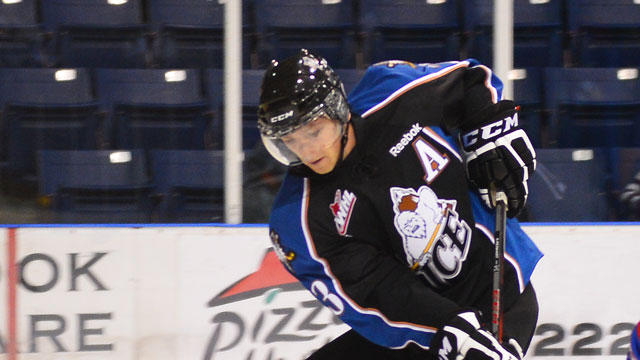The year of the … what? That’s the takeaway from talking to NHL scouts about this year’s draft class. Not that it’s bad—though the media will talk about there being “weak” draft classes, scouts typically don’t. They will talk about “strong” drafts or “deep” drafts. They’ll talk about “top-heavy” drafts that have a significant separation between the elite prospects and the pack. They will, like media fans, talk about “fall-off points,” about drafts that are eight-deep or 10-deep or maybe 14-deep. “Weak,” though, they avoid. Maybe it’s not to offend prospects that their teams will end up selecting. After all, no kid wants to be thought of as the best of a bad lot.
This is to say that, at this point, the 2014 draft class is sort of shapeless, ambiguous maybe. There isn’t a consensus No. 1, the dominant prospect and franchise player along the lines of a Crosby. There isn’t a battle for the top spot between two or three players, no Ovechkin vs Malkin, MacKinnon vs Jones.
When you break it down by source regions isn’t much help.
It’s not the year of the Q. The Quebec Major Junior Hockey League has had a huge impact on the last couple of drafts, coincident with their great run in the Memorial Cup. But this year, most scouts figure that there is but one kid in the Q who’s pegged as a first-round talent (Moncton’s Ivan Barbashov) and they’ll say that the ability to sign him makes it no guarantee that he’ll land in the top 20.
It’s not the year of the Dub. In 2012, five of the first eight picks were drawn from the Western Hockey League and you’d think that the WHL was ascendant. Proof that hockey life goes in cycles came last year when Seth Jones was the only WHLer in the top 12. The letdown next June might even be more acute. Not that the Dub won’t have numbers through the first round but rather the source: The consensus is that the two of the three best prospects are imports. In fairness, homegrown Kootenany centre Sam Reinhart has a shot at being the top pick, but scouts are buzzing about German centre Leon Draisaitl with Prince Albert and Finnish blueliner Julius Honka in Swift Current.
It’s not the year of the O. True, the Ontario Hockey League has more likely first-rounders than the other two loops in the CHL. According to NHL Central Scouting’s list of early-season players to watch, there are 10 projected to go in the first 30 in June. Still, this isn’t anything like the 2008 draft when Stamkos, Doughty, Bogosian and Pieterangelo capped the draft. In the O, it’s sorta like Dining with the Three Bears: Scouts look at prospects and feel some are too hot, too cold or in fact too hot-and-cold. Maybe because they’re getting more intense viewing, the prospects are nit-picked apart. As a case in point, this was a slice from a scout’s assessment of Kingston centre Sam Bennett this week: “He has a lot of high-end skill and he’ll play in the league, but whenever I watch him it seems like he’s too busy … he works hard and is always doing something but it’s not having as big an impact as you’d like.”
There’s no relief outside CHL. The USDT won’t have too much sway. “Average,” says one scout with multiple views of the team out of Ann Arbor. And the consensus is that Minnesota high school hockey wouldn’t even rank as high as average. “It’s not a destination for us this year,” a Western Conference scouting director said. Will a European theme emerge? Possibly, but it’s still too early to say with most of the top scouts making their trips over to Europe in these and coming days for international U18 tournaments.
Said one scout: “We always say that you’ll get a player at No. 8 or No. 10, but this is really a year when you might get the kid who winds up being the best player in the class in the slot. Or maybe later.”
Scouts say something like that every year but this time they’re saying it with more feeling.
Notes: It looks like Hockey Canada will be make significant change in the format of the Under-17 Challenge in days to come. Teams have been drawn from the regions (East, Quebec, Ontario, West and Pacific) and that set-up has left the Maritimes and Prairie teams at something of a disadvantage over the years. Some details will be hammered out yet but it will be something more like the CHL Prospects Game with players assigned to team with no respect to regions. While this should have the effect of balancing power significantly, I have mixed feelings about it. I hope Hockey Canada gives kids who’ve been line mates and teammates on teams all the way up through minor hockey a chance to take the step up together. It will be a delicate balance to strike but the net effect—more balanced, competitive games, especially against international teams—makes it hard to argue against.

